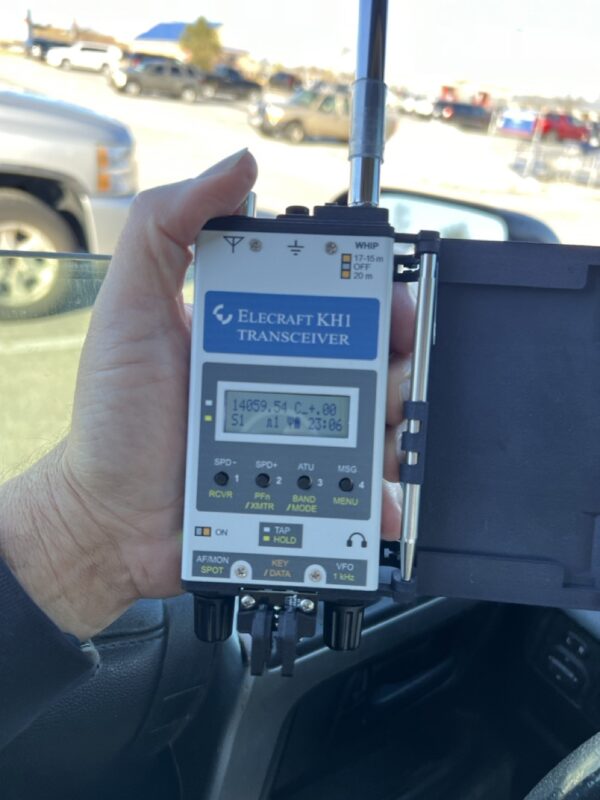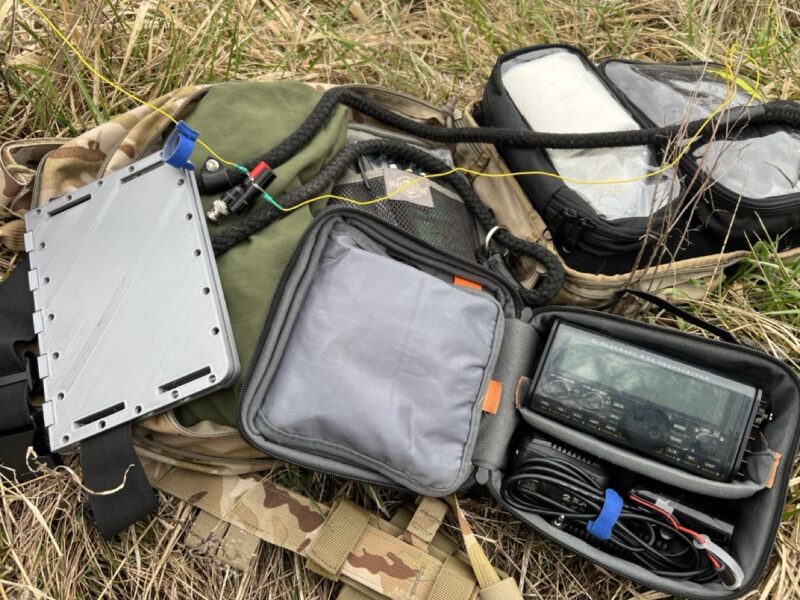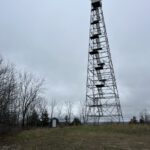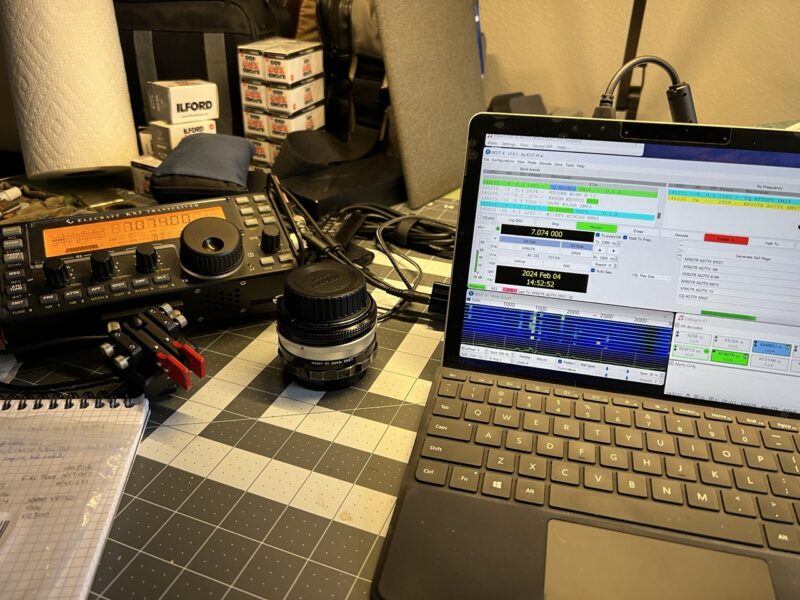
Setup
The American Radio Relay League (ARRL) hosts an annual radio event called Field Day. The objective is to get away from the home station, setup a station somewhere portable, and practice a field activation. There are lots of things to learn by operating portable and the lessons learned are valuable when the time comes to serve during events that need radio support or during emergencies. Although Field Day is not a contest per se, it is contest-like in that points are offered for contacts and bonus activities.
My friend Greg planned our expedition for weeks. We made a scouting run of the dry lake (above) a few weeks ago and it looked like a pretty good spot. It is relatively flat, far enough but not too far from the highway, and there is room for several stations.
My plan was to use my Elecraft KX3 with its panadapter and amplifier as my primary station. Given that Greg wanted me to run the VHF/UHF net (that we always do for Field Day), I also decided to take my Yaesu FT-857D because it is all band and all mode.
But, work kept delaying my preparations for camping. I also needed to replace the camper’s battery box because the lid of the original was lost during my trip home in early May. So, although I planned to leave Thursday afternoon, it was Friday morning before I finished the loadout and headed out.
Travel to Site

The access road from the state highway to the dry lake was slow. The road is rough from OHVs running hard on it. There are lots of loose rocks that are kicked out by those vehicles. There is also some rutting of the road from storm and snow runoff. I was often running a couple miles an hour and some stretches allowed a little more speed without beating up the camper or the rig. I think travel from the highway to the site required about 45 minutes or so.
When I arrived on site, both Greg/Subrina and Tim had their camps and stations set up.
Camp
I had no trouble getting camp setup and ready to support Sera and me. I have setup my camper so many times that it is nearly routine. The playa bed was relatively level although I did drop the tongue a half a foot to level the camper forward to aft. It was level enough laterally. However, I found myself stressed and in a hurry because of my late arrival. I really wanted to be setting up my station on Friday and not setting up camp.
Greg came over when he saw me putting up the EZ-Up. It is possible to set one up solo, but it is much easier with two people. I staked out the tie-downs carefully as well. The wind does blow on Nevada afternoons and has been known to fold up shelters (and tents… and awnings).
By the time I had camp setup, I was pretty much done, physically and mentally. So I elected to deploy my station Saturday morning and sat in my chair in the shade to collect my thoughts and relax.
Greg and Subrina graciously asked us to supper. Because I was not completely prepared for this outing, I had nothing to contribute — not even dessert.

Station

I got out the MPAS pack and started laying out the components on my work table. Unfortunately, the spike was missing. Tim, who had wandered over to watch my deployment said “I have a piece of 3/8-inch all-thread. I also have a three-foot 3/8-inch by 24 extension if you want to get the feed point off the ground.”
We drove over to his camp, retrieved the parts, and returned to my camp to complete the antenna deployment. We found the all-thread to be too flimsy to support the MPAS. Greg suggested he had a light fence post that might provide stability, so he and Tim walked over the Greg’s camp.
Tim returned with three posts, which was an excellent idea because we fabricated a tripod using the three light-duty posts and a heavy zip tie. This provided excellent stability of the antenna system and the feedpoint was about five feet above ground level.
I also had a speaker-wire doublet that I built that I considered deploying for a second antenna. However, after working so hard to deploy the MPAS antenna, I elected to use just one antenna.

I setup the Yaesu FT-857D and the LDG YT-100 matching unit on my worktable. I elected to use my 30Ah Bioenno LFP battery for power into a West Mountain Radio distribution block. I was unsure how much energy I might need so I added a PowerFilm 60w foldable solar panel to the mix into a Genasun GV-10 Lithium charge controller. I did no meter the power.
I chose the FT-857D for my Saturday outdoor operation because it includes the 2m and 70cm bands. Greg tasked me with net control duty for the local net we run at the beginning of Field Day. This affords the local operators a chance to get started with a set of contacts without the hassle of trying to break the initial pile-ups that occur on the bands.
A Microsoft Surface Go 2 has been my radio computer (and travel work computer) for a couple of years. It is a relatively low power computer, but it also does not use a lot of energy. This attribute, plus the fact that it has adequate power to run radio software, makes it an excellent computer for field work.
I ran an extension cable from the antenna in my 4Runner to the VHF/UHF output of my FT-857D.
This was followed by a little testing. I had an operational station for the start of Field Day 2024.
Operations
I started operation at 1100h local by calling on the designated frequency (VHF). Two of four known operators responded. This resulted in a trip by Greg to Fred’s camp to help him get his station sorted. After a few minutes, we had three of four planned operators all on the same frequency. The remainder had elected to camp outside the dry lake basin and could not be heard.
I ran the net on the designated frequencies with one flub — I forgot to pass control to the next operator on my list to make their contacts. Fortunately, I had my smarter brother Greg to remind me of my error. The net ran smoothly after that.
After the net closed, I puttered for a few hours playing search-and-pounce on running stations. Outside of our little group, I made only one or two contacts on phone; the remainder were all CW mode (Morse Code).
I had to move the shade tarp from the east side of my shelter to the west. The direct sun was too hot. The temperature was fine with the shade from the shelter (and tarp).
By sundown I had a few dozen contacts. I was not working that hard, but really enjoying being away from the house, the cooler weather (at altitude), and the sound of the radio. When we met for the evening break, we all had about the same number of contacts by straw poll.
I returned to camp, moved the antenna connection indoors, and connected it to the Elecraft KXPA100 amplifier for my KX3/PX3 station. I had a little setup to do before I was ready to run indoors, but that did not take long.
After getting The Girl out for a break (and feeding her), I sat down at the radio and worked stations I could hear. I probably worked until about 2200h local before retiring for the night.
As is usual for me, I woke about 0500h when night turned into twilight. I turned on the radio and made a coffee while listening to the background noise of the HF bands. I also stepped outside to look around and enjoy the cool morning air before returning to the station and working more operators.
I shut down about 1100h, satisfied with my 140 contacts.

Conclusion
I spent the remainder of Sunday with my friends and relaxing in the shade at my camp. Fred tore his station down, packed up, and headed home. He had work Monday. I offered help to Greg and Tim with tearing down their stations, but both had the chores handled. We are all experienced field operators.
I put away the FT-857D station and stowed it in the 4Runner. As I write, I cannot remember if I put away the Elecraft KX3 station or not. I think that I did, knowing that I would be up and wanting to break camp Monday morning.
Monday morning I rose, made a coffee, and stepped outside the camper to enjoy the morning air. I was treated to a beautiful alpenglow on a nearby mountain, this caused me to make a photograph. I decided to get out the DJI Mini and see if the batteries had any charge. Once again, I brought the tool but had not prepared it before leaving home.
Of course, none of the batteries carried a full charge. But I was able to fly a circuit around the dry lake and make a few aerial images.
I finished my coffee and made another. Sera and I walked to the other camps to see if anyone needed help. All were good.

Things Learned
- Sometimes stuff happens. In this case, the stuff was me being busy with other things than preparing for the 2024 Field Day expedition. This resulted in a delay of my planned departure and then the compression that comes from being late. It added unnecessary stress to my life and my setup.
- Always check your equipment before leaving home. I had alternatives, but it is better to have a complete antenna system from the start.
- Always have a backup plan. I had several other antennas I could deploy in the back of the 4Runner. I always carry spares.
- Always carry spare parts and supplies. You might not need them, but another operator in your group could have a failure or be missing a critical piece of equipment for operations. Be prepared to help out other operators in your group.
- Be prepared to offer physical assistance to other operators in your group. Some equipment is much, much easier to deploy with a second set of hands. Sometimes an additional brain is of use as well as all of us can get locked in a loop when trying to solve a problem.
- The addition of a tarp to extend the shade of the EZ-Up was necessary. The sun was too bright to readily read the SG2 screen and direct sun provided a lot of unwanted heat. A second tarp would be a good addition so that one could be setup on west and east sides of the EZ-Up. However, I would leave the north and south facings open for air flow on summer outings.
- From an operational standpoint, I had fun. I did not burn up the ether trying to make a lot of contacts. I am not sure that I want to do that, as I operate a radio for fun and for practice should I need to run a radio. I operate portable (a lot) because I want to get out of the house and because there is so much noise at my house. But, I think maybe I should be a little more serious during one of these outings and keep my butt in the chair and run frequencies. It would be good practice to push the operation a little harder.
It was a good Field Day outing. I had fun playing radio. I learned a few things, as I generally do on a field deployment. I enjoyed my friends. My dog and I had a blast. Everyone was safe and seemed happy to be in the field together.
I am grateful. Life is good.
















